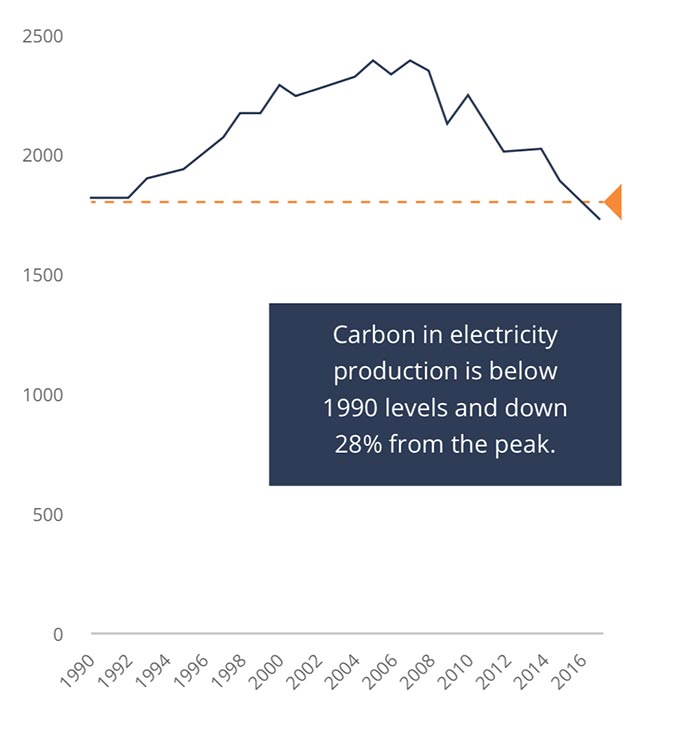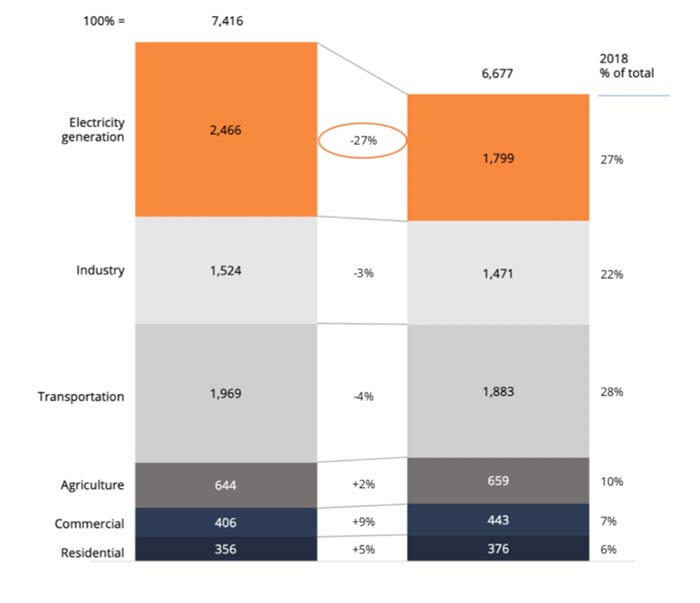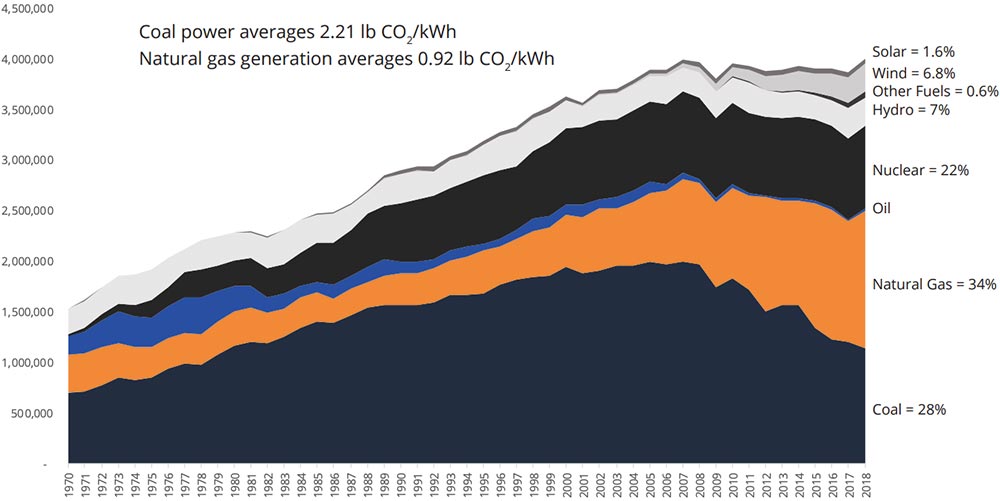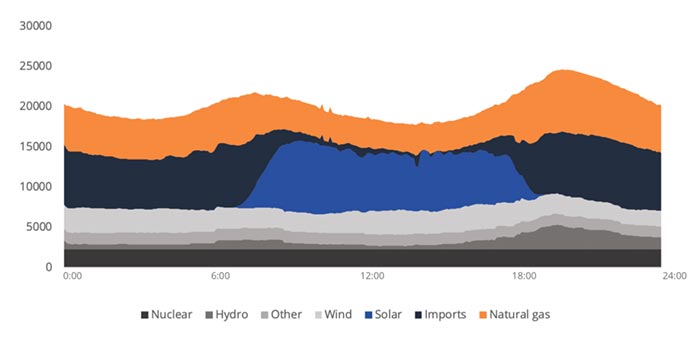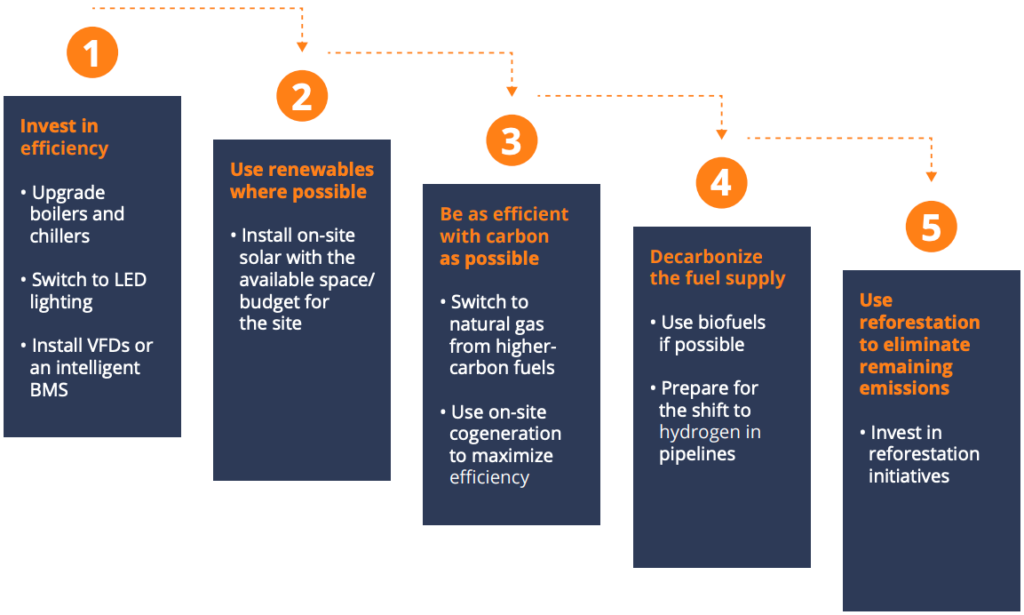The Path To Carbon Neutral – The Need for an On-Site Solution

To prevent irreversible climate change, the consensus is we need our economy to be carbon neutral by 2050. Although 100% renewable at a societal level is unlikely in the short term, there is a clear path for cutting facility emissions to be carbon neutral today.
Consensus scientific opinion is that climate change will become irreversible once we reach a 1.5°C rise in average temperatures. Although the U.S. has reduced our carbon emissions below 1990 levels, that is not enough.
In order to remain below the 1.5°C targets, current research suggests our society needs to become carbon neutral by 2050.1
States are leading the charge in the effort to become carbon neutral. California has issued an executive order announcing that it will be carbon neutral by 2045,2 while New York has set a similar target of 2050.3 Other states are sure to follow. As news headlines suggest, massive investment in renewables, storage, and electrification seems like the path forward.
The good news is that by 2018, the U.S. had already reduced its CO₂ emissions to 6,676 million metric tons, equivalent to 1990 levels, from a peak of 7,416 million metric tons in 2007.
What Is Causing the Decline in Emissions?
Electricity generation has been the primary driver of the overall decline in emissions. Since reaching 2,466 million metric tons in 2007, emissions from electricity generation fell by 27% to 1,799 million metric tons in 2018, representing 90% of the total emissions decline across industries during this period.
Carbon savings in the power generation sector can be attributed entirely to the decline in coal generation, from about 50% of U.S. electricity production in 2007 to 28% in 2018. During that same period, aggregate electricity demand in the U.S. remained flat. Growth in cleaner-burning natural gas power replaced 63% of the decline in coal production, resulting in an emissions reduction of 352 million metric tons of CO₂.
Solar and wind power replaced the other 37% and resulted in a reduction of 319 million metric tons. During this time, nuclear and hydropower production has remained essentially flat.
Continuing the shift away from coal will further decrease carbon emissions for the power sector as a whole. At the same time, increasing the share of renewables will have an enormous impact, especially as the transportation sector continues to electrify and place significant strain on the existing grid infrastructure.
However, there are some barriers to the widespread deployment of renewable technology, making it unlikely that the grid will shift to 100% renewables in the next 20 years. Natural gas will continue to play a critical role as a dispatchable generation source that is much cleaner than coal. In addition, a clean grid only addresses part of the problem for most facilities, as electrification is not typically a feasible solution for on-site thermal loads — preventing facilities from fully reaching carbon neutrality
Emissions by industry, 2007 vs. 2018
5 Millions of metric tons of CO₂
Electricity Production by Source
What Hurdles Exist for a 100% Renewable Grid?
The grid can and should incorporate more renewables. However, while we continue to invest in renewables, we need to recognize and plan for their inherent limitations. Reaching carbon neutrality is not as simple as continuing the current trend and replacing all existing coal and natural gas plants with renewables. Wind and solar technologies create their own problems. Solar panels require large amounts of space while sitting and permitting wind turbines is not easy given the need for sufficient year-round winds and frequent local political and environmental opposition.
Intermittency of supply might be the most significant barrier to using renewables as the only generation source on the grid. Solar and wind combine to make up 23% of California’s annual energy supply; however, that production is highly variable.7 Solar production occurs during daylight hours but is still highly volatile on a day-to-day and minute-to-minute basis. Wind production is even harder to predict.
Something needs to step in and fill the gaps with capacity available on-demand when renewables are not available, and currently, natural gas peaker plants provide most of that capacity. See the following example for one day of production in California. Both the brief mid-day and extended overnight drops in renewable production are counterbalanced by in-state natural gas power plants and electricity imports, which include natural gas, coal, nuclear, and hydropower resources from neighboring states.
Wind Production, California April 2019 – Thousands of MWh
Solar Production, California April 2019 – Thousands of MWh
Daily Generation by Source, California, April 1, 2020
Research indicates that as the share of renewables exceeds 50% of total production on the grid, the land area and investment needed to provide reliable grid power escalates dramatically. Balancing the grid in high-renewables scenarios would require a massive overbuilding of energy storage and renewable generation, resulting in a total system capacity of 3 to 8 times the system’s annual peak demand, according to a range of scientific estimates (total installed capacity is 1.5 times greater than U.S. peak demand today).14 Costs are likely to keep this solution out of reach:
Even at $100 per kWh of installed energy capacity (less than a third of today’s costs), enough Li-ion batteries to store one week of United States electricity use would cost more than $7 trillion, or nearly 19 years of total United States electricity expenditures.
The massive investment required to implement sufficient renewables — plus the cost of overcoming the intermittency challenge with sufficient storage — suggests that for the foreseeable future, utilities must continue to utilize natural gas and other dispatchable resources to cover both nights and multiple cloudy, windless days when renewables are unproductive for long stretches.
Facilities Still Need Feasible Solutions to Cover Thermal Loads
In total, only 27% of U.S. emissions come from electricity generation. Industrial emission sources contribute an additional 22%, mostly due to process heating, while commercial and residential sources add another 13% from space heating in buildings and homes. In fact, a typical hospital or industrial facility generates at least 30% of its total carbon emissions from gas boilers. Even a 100% renewable grid would not impact this part of a facility’s footprint, so sites must explore other solutions to reach carbon neutrality for the entire facility. Electrifying thermal loads with electric boilers and furnaces is a potential solution that would allow for greater on-site usage of renewable electricity. However, this is not currently cost-effective anywhere in the U.S. due to a few simple considerations:
- Electric and gas boilers or furnaces have similar efficiency ratings, but gas is 2 to 3 times cheaper than power in the U.S., so operating costs are much higher with electric heating, even in residential applications.
- Most industrial processes require high-temperature heat (>700°C). It would take significant investment to redesign existing furnaces and boilers to use electricity instead of fossil fuels. Typically, solutions like this are not commercially available.
- Industrial processes are highly integrated with heat exchangers that link independent unit processes. Electric furnaces will not produce the same level of excess heat needed for neighboring processes (i.e. steam-driven compressors or turbines). This would require significant adjustments to other production stages, at a prohibitive cost.
Due to these factors, electric boilers and furnaces are not currently a cost-effective solution for facility thermal loads. The one technology that can drive total facility CO₂ reductions in an economical way is a highly efficient on-site cogeneration system. By using waste heat from the electric generator, the cogeneration system can dramatically reduce the amount of natural gas used by thermal loads at the facility, resulting in significant carbon savings.
How Facilities Can Take Action
For those responsible for energy-intensive facilities, this is our problem to solve. While it is not economically feasible for most facilities with large
thermal loads to reach carbon neutrality without some sort of carbon credits, it is not enough to wait for the grid to become 100% renewable. Nor is it enough to simply purchase wind and solar credits without making any on-site changes.
You have more control over your emissions than you think. The five-step path to carbon neutral includes on-site measures: 1) Install efficiency upgrades. 2) Deploy on-site renewables where possible. 3) Implement cogeneration to lower emissions for both electric and thermal loads. 4) As the technology evolves, choose biogas and hydrogen solutions to make on-site, fuel-burning systems even more efficient. 5) Invest in reforestation to actively remove remaining carbon emissions from the atmosphere.
Fortunately, these on-site investments can also cut your energy bill while reducing your carbon footprint. Many of these steps are self-funding — and by implementing some or all, you may eliminate the need to reinvest in reforestation. Carbon neutral can also cost-neutral or better.
The Five Steps to Carbon Neutral
If you’re interested in a path to a low-carbon future, Unison Energy is here to help with all five steps on the path to carbon neutral. Our microgrids provide onsite generation using cogeneration, solar, and battery storage to optimize client carbon savings. At client request, we often invest in central plants for boiler or chiller upgrades, lighting retrofits, and electrical system upgrades. We also work with our partners to fund reforestation efforts, helping our clients reach their goals for 100% carbon neutrality.
Click here to learn more about how to cut your carbon footprint in Part 2 of this blog, “The Path to Carbon Neutral: Five Steps to Cut Facility Emissions”.
For more insight into how Unison Energy’s solutions can cut emissions at your facility, click here to contact Unison Energy.
Energy insights, delivered
Subscribe for more content.
Related Blogs
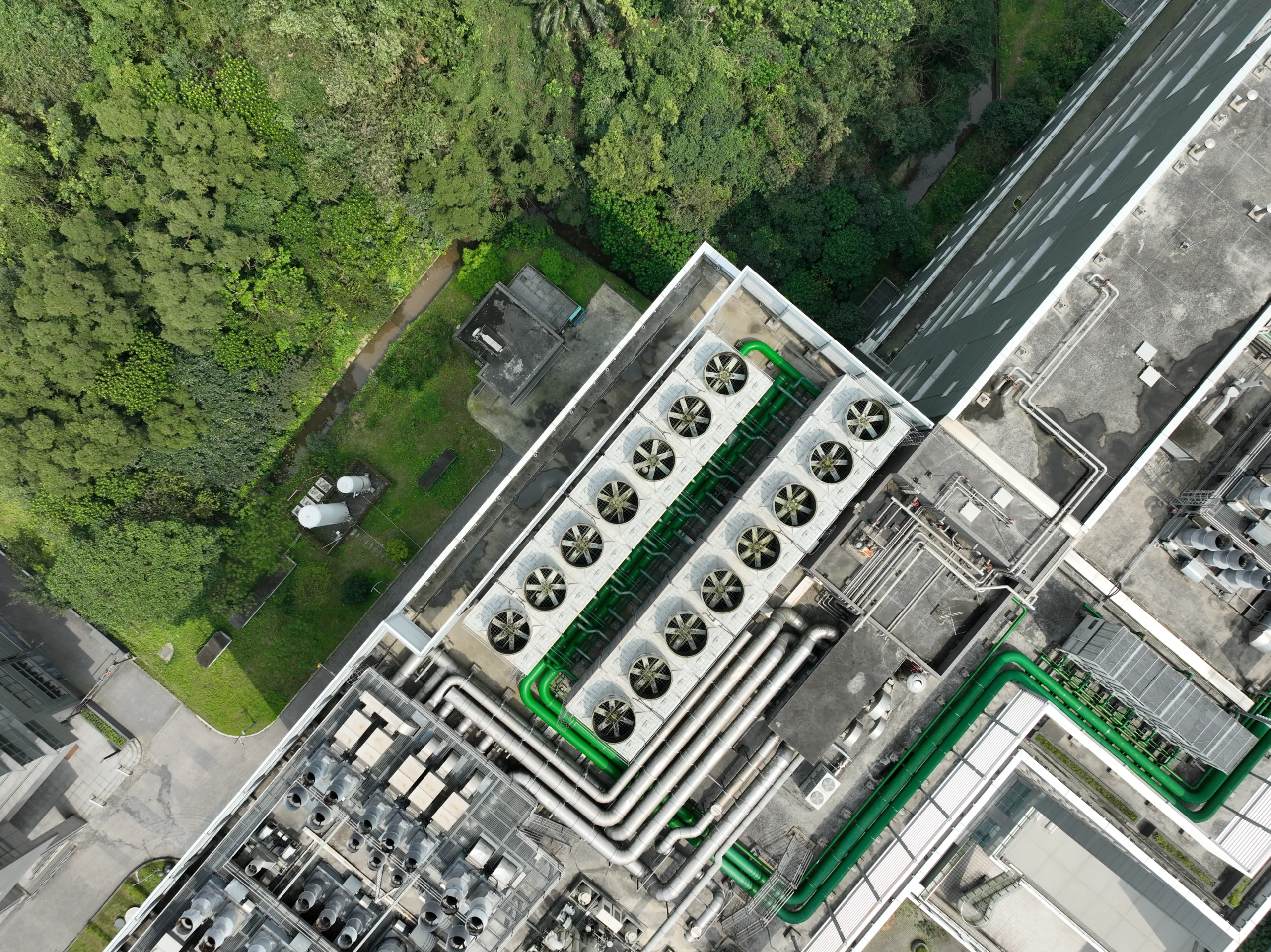
From Kill Switches to Tariffs: Policy Shifts Reshaping U.S. Data Center Growth
The Energy Crisis in Healthcare: Mitigating Financial Losses Through Reliable Power Solutions
Deadlines for the Inflation Reduction Act
